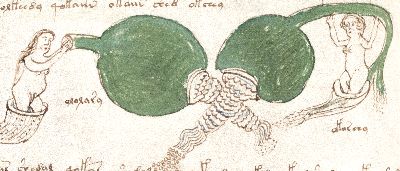A while back, I posted about how the name “Voynich Manuscript” implicitly contains two lies – for one, it had been known for centuries prior to Wilfrid Voynich; and for two, you can only properly call something a “manuscript” if it was produced before 1450, which seems not to be the case here (though probably by only a whisker).
Much the same kind of thing goes for any discussion of “quires” – this too is carrying a heap of linguistic baggage which we should at least be aware of. So: what exactly is a quire, then?
Probably the best starting point is to step through the vellum manufacturing process from the start. Once a suitable animal (typically calf, lamb or goat kid) had been killed and its rawhide (literally its “raw hide”) flayed from the carcass, that hide had to be soaked and pounded (to remove the flesh from the “flesh side” and the hair fibres from the “hair side”) and then “tanned” (to prevent it from rotting). The beautiful thing is that soaking a rawhide for several days in just the right kind of noxious goo (this is called “liming” if you use lime, or “bucking” if you use wood ash) transforms its protein structure and thereby turns that hide into something that will (if kept properly) stay stable for decades, if not centuries – leather.
However, to be able to write satisfactorily on it, freshly-limed leather has to be dried on a stretching frame, “scudded” (to remove any remaining hairs), smoothed with a pumice stone, pounced (roughened up again, otherwise it would be too slippery to write on), and whitened. What you end up with is a piece of writable leather – vellum or parchment. Having said that, given that I have seen at least ten different opinions on what should be called “vellum” and what should be called “parchment”, my best advice is simply to call all writable leather “vellum” and move swiftly on.
Of course, because animal skins don’t come in perfectly book-sized and -shaped dimensions, the large piece of vellum you have just produced then has to be folded, cut and trimmed into a more useful size. By doing this in the most obvious way, you would end up with a nested set of bifolios (double pages with a fold down the middle) where each facing pair of folios has a flesh side or a hair side. This isn’t necessarily always the case, but it does seem to be a rule of thumb that is generally followed.
[Incidentally, the plural of folio is folios, of folium is folia, of bifolio is bifolios, and of bifolium is bifolia. Ignore any Internet nonsense that mixes any of these pairs up, as well as the occasionally-seen foolish assertion that the plural of folio is folio’s. *sigh*]
What you are then holding is called an unsewn gathering – a folded set of loose bifolios. If these are then sewn together (the needle holes down the central fold are called the “sewing stations”), they are called a sewn gathering.
But this is not yet a quire. Strictly speaking, a quire is a part of a set of sewn gatherings that have been sequentially ordered (the ordering mark is known as the “quire signature”, typically numbers or letters – ‘i’ / ‘ii’ / ‘iii’, ‘a’ / ‘b’ / ‘c’, etc) ready to be bound together – until such time as . There are therefore two basic forms of quires: unbound quires (a set of gatherings that have been ordered but not yet bound) and bound quires (a set of gatherings that have been both ordered and bound). You can also sometimes find an unordered set of gatherings bound together: but without quire signatures (which were normally placed on each quires’ back page), these aren’t really quires per se.
Confusingly, many texts also refer to gatherings or quires as “quire signatures”: though this is a good example of metonymy (using a part to stand in for a whole), in this context it only really serves to muddy the waters.
In the case of the enciphered Voynich Manuscript, we have a basic codicological dilemma: even though the bifolios have been sewn and bound together into quires, there seems little doubt that the various people who added the quire numbers (i.e. the quire signature numbers) did so without being able to read the contents – and because the original bifolio grouping, sewing, and binding order has been lost, we don’t know what the original gathering structure was.

Voynich Manuscript f83v – enciphered “X”?
And so if the Voynich Manuscript turns out to have enciphered quire numbers (for example, given that f83v was probably the back page of a quire, the drawing there might contain an enciphered “X” to denote “Quire #10”), then it originally was an ordered set of quires (though whether unbound quires or bound quires isn’t known) – but if it didn’t, then it was originally an unordered bundle of gatherings. Or it might have been partially ordered (and so be a mixture of quires and gatherings). We just don’t know… yet!
Hi Nick! So, a quire is a sewn gathering with an ordering mark of some kind, and if a gathering doesn’t have any ordering mark, then it’s just a gathering? As you say, it’s then conceivable that originally the VMs was an unordered bundle of gatherings. It could also have been a set of unbound quires, ie. sewn gatherings that the Author gave enciphered quire signatures to, but did not bind and just left loose.
Exactly what does binding involve in this case?
Cheers,
Dennis
You’ve got the basic picture just fine! 🙂
Binding is a subject for another post entirely… I had to draw a line under this one somewhere. 🙂